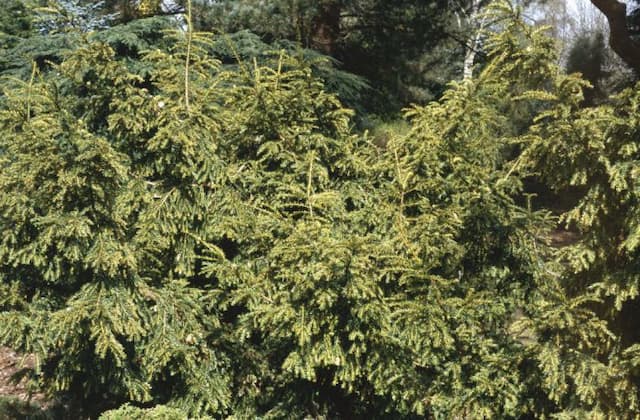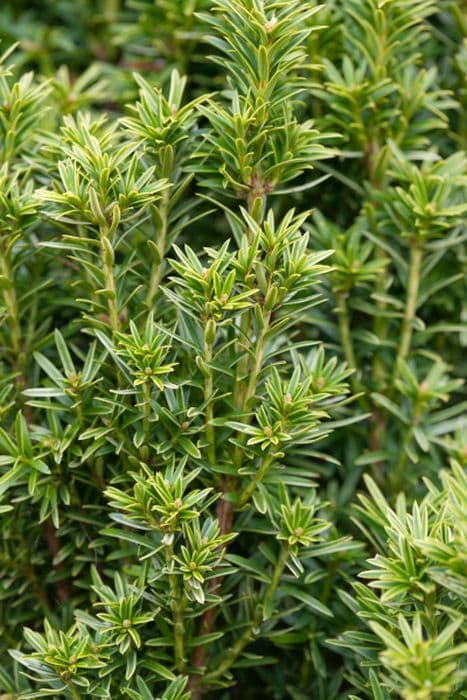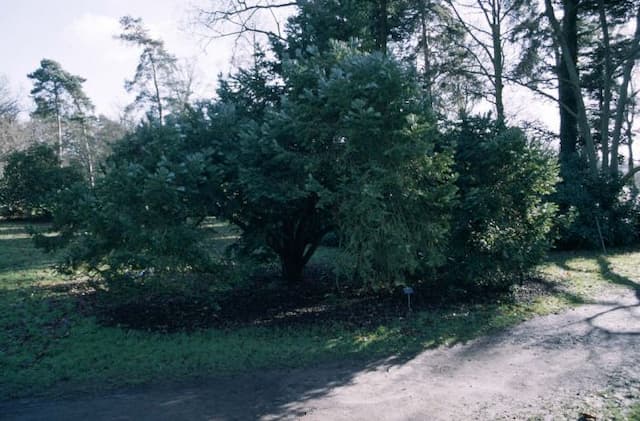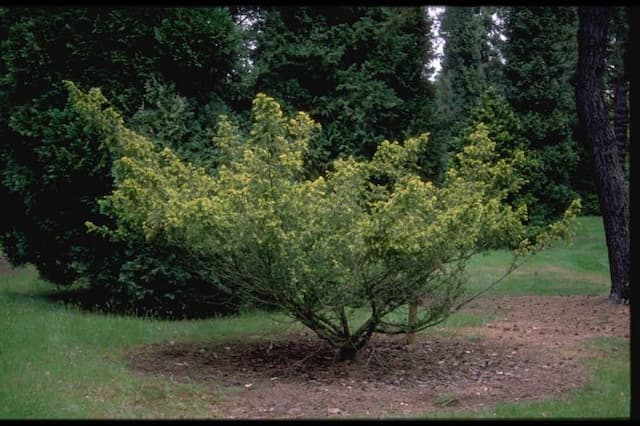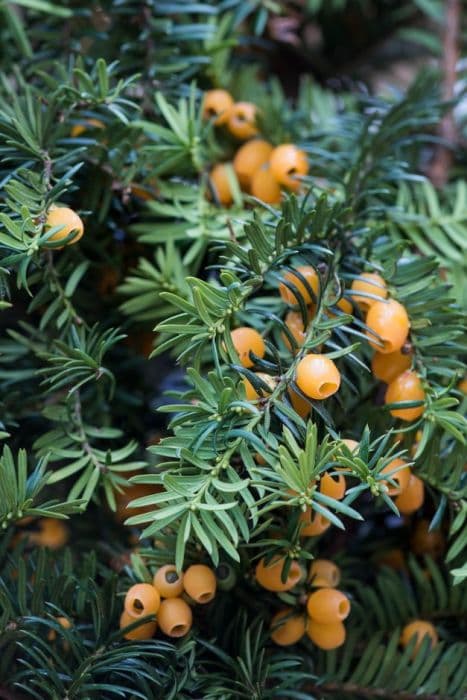Irish Yew Taxus baccata 'Fastigiata Aureomarginata' (m/v)

ABOUT
The English Yew 'Fastigiata Aureomarginata' is a distinctive evergreen conifer known for its striking foliage and elegant form. It displays a columnar growth habit with a vertical orientation, and its branches grow upright, lending it a narrow, pillar-like silhouette that stands out in gardens and landscapes. The leaves of this particular variety are unique, as they feature a variegation that sets them apart from other English Yews. Each needle-like leaf is edged with a bright, golden-yellow margin, creating a striking contrast against the darker green of the inner portion of the leaf. This variegation adds a splash of color to the plant year-round and can illuminate a shaded spot within a garden setting. The English Yew 'Fastigiata Aureomarginata' also produces signature red berry-like structures, which are actually modified cones with a fleshy covering. These vibrant fruits add further interest to the plant, especially in contrast to the variegated foliage, although it's important to note that they are toxic if ingested. Overall, the striking variegated leaves, the compact, upright growth habit, and the showy red fruits make the English Yew 'Fastigiata Aureomarginata' a visually appealing and ornamental addition to any landscape, where it provides year-round interest without taking up too much lateral space.
About this plant
 Names
NamesFamily
Taxaceae
Synonyms
Golden Irish Yew, Aurea Marginata, English Yew Aureomarginata
Common names
Taxus baccata 'Fastigiata Aurea', Taxus baccata 'Aureomarginata', Taxus baccata 'Elegantissima'
 Toxicity
ToxicityTo humans
The common name for Taxus baccata 'Fastigiata Aureomarginata' is the English yew. This plant is highly toxic to humans if ingested. All parts of the English yew contain toxic compounds, particularly taxine alkaloids, although the red aril (the fleshy part surrounding the seed) is less toxic and sometimes even consumed by wildlife. Symptoms of English yew poisoning can include dizziness, dry mouth, dilated pupils, weakness, an irregular heartbeat, and can progress to severe gastrointestinal symptoms, such as nausea, vomiting, abdominal pain, and diarrhea. Ingesting parts of the yew can also affect the cardiovascular system, leading to life-threatening complications such as arrhythmias, acute heart failure, and even death, if not treated promptly.
To pets
The common name for Taxus baccata 'Fastigiata Aureomarginata' is the English yew. This plant is highly toxic to pets if ingested. The English yew contains toxic alkaloids throughout all parts of the plant, with the exception of the red aril. Pets, such as dogs and cats, that ingest any part of the English yew may show a range of symptoms, including vomiting, diarrhea, difficulty breathing, weakness, changes in heart rate, tremors, seizures, and potentially heart failure. Ingestion of English yew can be fatal to pets and requires immediate veterinary attention.
 Characteristics
CharacteristicsLife cycle
Perennials
Foliage type
Evergreen
Color of leaves
Green
Height
6-10 feet (1.8-3 meters)
Spread
2-3 feet (0.6-0.9 meters)
Plant type
Shrub
Hardiness zones
7
Native area
Europe
Benefits
 General Benefits
General Benefits- Ornamental Aesthetics: Taxus baccata 'Fastigiata Aureomarginata', commonly known as the Golden Irish Yew, provides year-round ornamental interest with its striking golden-edged foliage and upright, columnar form, which can enhance garden design.
- Habitat for Wildlife: This plant offers habitat and protection for various wildlife, including birds that may nest in its dense branches.
- Drought Tolerance: Once established, the Golden Irish Yew is known for its ability to withstand periods of drought, reducing the need for frequent watering.
- Shade Tolerance: It can grow well in shaded areas where other plants might struggle, making it a versatile choice for different garden locations.
- Low Maintenance: It requires minimal pruning and care once established, making it a convenient choice for gardeners of all skill levels.
- Privacy Screening: Due to its dense growth habit, it can be used to create effective privacy screens or living walls in landscapes.
- Soil Adaptability: The plant is adaptable to a wide range of soil types, though it prefers well-drained, fertile soil, making it suitable for many garden settings.
- Long Lifespan: With proper care, the Golden Irish Yew can live for a very long time, providing a lasting structure and presence in a garden or landscape.
- Seasonal Interest: It offers seasonal interest with its evergreen foliage and the contrast between new and old growth.
- Structural Garden Element: Its distinct shape can serve as a structural element in formal gardens, guiding the eye and providing a backdrop for other plants.
 Medical Properties
Medical Properties- Source of Taxol: The English yew (Taxus baccata) contains precursors to the drug paclitaxel (Taxol), which is used in cancer treatment, especially for ovarian and breast cancers.
- Anti-cancer Alkaloids: Aside from Taxol, the yew tree produces other alkaloids with potential anti-cancer properties.
- Historical Treatment for Epilepsy: There have been historical accounts where extracts from the yew have been used to treat epilepsy, though its current use and efficacy for this purpose are not supported by modern scientific evidence.
 Air-purifying Qualities
Air-purifying QualitiesThis plant is not specifically known for air purifying qualities.
 Other Uses
Other Uses- Woodworking and crafting: The wood of the Yew is hard and durable, making it ideal for creating walking sticks, furniture, and intricate wooden crafts.
- Garden sculpture: With its dense foliage and unique coloration, the Yew is excellent for topiary art, giving gardeners the chance to sculpt living art pieces.
- Soundproofing: Yew hedges, due to their dense nature, can act as natural sound barriers in gardens and along property lines to reduce the impact of traffic noise.
- Privacy screening: The dense, columnar habit of the Yew makes it suitable for planting as a privacy hedge to enclose a garden space or patio area.
- Winter garden interest: In landscapes that turn bleak in winter, the evergreen Yew adds color and structure, providing visual appeal during the dormant months.
- Windbreaks: When planted in rows, Yews can serve as windbreaks to protect more delicate plants or to reduce wind speed on a property.
- Erosion control: The root system of the Yew is effective at stabilizing soil and preventing erosion on slopes or banks.
- Bonsai cultivation: Due to its slow growth and ability to respond well to pruning, the Yew is an excellent candidate for bonsai creation.
- Wildlife habitat: While the berries are toxic to humans, they can provide a food source for certain bird species, offering an ecological benefit to the garden.
- Shade provision: Larger specimens of the Yew can offer shade in a garden, creating cool spots during sunny days for underplanting or peaceful seating areas.
Interesting Facts
 Feng Shui
Feng ShuiThe Irish Yew is not used in Feng Shui practice.
 Plant Symbolism
Plant Symbolism- Eternity: Taxus baccata, commonly known as the English Yew, is considered a symbol of eternity because the tree is extremely long-lived and can essentially survive for centuries.
- Resurrection: The Yew tree is often found in churchyards and is thought to symbolize resurrection; this association comes from its ability to regenerate from old wood as well as its evergreen nature, which represents enduring life.
- Immortality: The enduring nature of the Yew tree's life, its resistance to decay and disease, and its evergreen quality have led to it being used to represent immortality or the undying aspect of the human soul.
- Protection: In mythology and folklore, the Yew was believed to protect against evil and was planted in graveyards to safeguard the dead, which makes it symbolic of protection.
- Transformation: With its capacity to regenerate and form new shoots from old wood, the Yew symbolizes transformation and the possibility of renewal and change.
 Water
WaterThe Irish Yew needs consistent moisture, but it's important not to overwater. It should be watered deeply once or twice a week, depending on weather conditions, providing it with about 1 to 1.5 gallons per session during the growing season. In winter, reduce the amount as the plant requires less moisture due to slower growth. Always check the soil before watering; it should be moist but not soggy. To prevent root rot, water at the base of the plant, avoiding wetting the foliage.
 Light
LightThe Irish Yew thrives best in partial to full sun exposure. An ideal spot would provide the plant with morning sunlight followed by some afternoon shade, or dappled light throughout the day. Avoid deep shade as it can lead to sparse foliage and a less vigorous plant.
 Temperature
TemperatureThe Irish Yew prefers temperate climates and can generally survive temperatures as low as 15 degrees Fahrenheit, but it is happiest when temperatures range between 60 to 70 degrees Fahrenheit. It can withstand a maximum temperature range up to about 90 degrees Fahrenheit. Ensuring the plant is properly mulched will help buffer soil temperature extremes.
 Pruning
PruningPruning the Irish Yew should be performed to shape the plant, remove damaged branches, and maintain its dense, upright form. It's best to prune in late winter before the onset of new growth, or in early summer after the spring growth flush. Prune sparingly, as heavy pruning can cause the plant to grow back too thickly, which can lead to issues with air circulation.
 Cleaning
CleaningAs needed
 Soil
SoilThe Irish Yew (Taxus baccata 'Fastigiata Aureo-marginata') thrives best in well-draining, fertile soil with a pH ranging from slightly acidic to neutral (pH 5.5 to 7.5). A good soil mix for this plant can be composed of equal parts loam, peat, and sand to ensure proper drainage and fertility.
 Repotting
RepottingThe Irish Yew generally requires repotting only every few years, as it is a slow-growing plant. It should be repotted in the event of outgrowing its pot or when the soil becomes compacted and no longer drains well.
 Humidity & Misting
Humidity & MistingThe Irish Yew prefers moderate humidity levels but is quite adaptable to various conditions and does not require specific humidity adjustments when grown in most outdoor environments.
 Suitable locations
Suitable locationsIndoor
Place in bright, indirect light, keep away from heaters.
Outdoor
Plant in well-drained soil, partial to full sun.
Hardiness zone
5-7 USDA
 Life cycle
Life cycleTaxus baccata 'Fastigiata Aureomarginata', commonly known as the Golden Irish Yew, begins its life cycle as a dormant seed which requires a period of cold stratification to germinate. Once the seed has germinated, typically in spring, a young seedling emerges and establishes its root system. Over the years, the seedling grows into a juvenile plant, developing its characteristic upright, columnar shape with yellow-edged evergreen leaves. As an adult, the Golden Irish Yew reaches reproductive maturity, producing small, inconspicuous male and female cones on separate plants; the female cones develop into the red, berry-like structures called arils. The plant can live for several centuries, continuing to grow slowly and reproduce, with older specimens often developing thick, gnarled trunks. Eventually, the plant enters a senescence phase, where growth slows, and it becomes more susceptible to disease and environmental stressors before finally dying.
 Propogation
PropogationPropogation time
Early Spring
Taxus baccata 'Fastigiata Aureomarginata', commonly known as the golden Irish yew, is most commonly propagated by cuttings. The ideal time for taking cuttings is during the late summer or early fall. To propagate, one would take semi-hardwood cuttings from new growth that has begun to harden. The cuttings should usually be about 4-6 inches (approximately 10-15 cm) in length. The leaves on the lower half of the cutting should be removed, and the cut end can be dipped in rooting hormone to encourage root growth. The cutting is then planted in well-draining soil and kept moist. It should ideally be placed in a location with indirect light and may take a number of weeks to root successfully.
